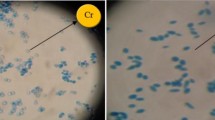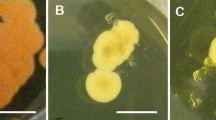Abstract
Tchoukoutou is a Beninese African sorghum beer obtained by mixed fermentation including different yeast and lactic acid bacteria (LAB). Until now, the make-up of the starter’s whole microbial communities and the main reason for the diversity of this special beer’s organoleptic quality (taste and flavor) have remained unknown. A total of 240 yeasts isolated from a Tchoukoutou starter have been characterized following the polyphasic approach and using yeast phenotype (morphology and physiology), proteins (MALDI-TOF MS), ITS1-5.8S-ITS4 and D1/D2 of the large subunit (LSU) rRNA gene as biomarkers. The microbial ecology of the starter used to produce Tchoukoutou is diverse and belongs to different strains of four species including Saccharomyces cerevisiae (75.17 %) as the dominant yeast, followed by Pichia kudriavzevii (17.24 %), Candida ethanolica (4.14 %) and Debaryomyces hansenii complex (3.45 %). D. hansenii complex and C. ethanolica are two yeast species which have never yet been isolated from Tchoukoutou. Some S. cerevisiae with an interesting fermentative profile are able to metabolize lactic acid (lactic acid bacteria metabolite) and therefore may increase the beer pH, thereby allowing the growth of LAB for further beer maturation and flavor enhancement during Yeast-LAB mixed fermentation. The co-presence of the non-Saccharomyces with S. cerevisiae in sorghum beer starter depends for the agroecology zones.





Similar content being viewed by others
References
Odunfa SA (1985) African fermented Foods. In: Wood BJB (ed) Microbiology of fermented foods. Elsevier Applied Science, London, pp 167–195
Osseyi EG, Tagba SD, Ketevi AP, Lamboni CR (2011) Stabilization of the traditional sorghum beer, “Tchoukoutou” using rustic wine-making method. Av J Food Sci Technol 3:345–358
Lyumugabe F, Gros J, Nzungize J, Bajyana E, Thonart P (2012) Characteristics of African traditional beers brewed with sorghum malt: a Review. Biotechnol Agron Soc Environ 16:509–530
Kayode APP, Deh DC, Baba-Moussa L, Kotchoni SO, Hounhouigan JD (2012) Stabilization and preservation of probiotic properties of the traditional starter of African opaque sorghum beer. Afr J Biotechnol 11:7725–7730
Schoustra SE, Kasase C, Toarta C, Kassen R, Poulain AJ (2013) Microbial community structure of three traditional Zambian fermented products: Mabisi, Chibwantu and Munkoyo. PLOS One 8:e63948S
Oliveira PM, Zannini E, Arendt EK (2013) Cereal fungal infection, mycotoxins and lactic acid bacteria mediated bioprotection: from crop forming to cereal products. J Food Microbiol 37:78–95
Laitila A, Sweins H, Vilpola A, Kotaviita E, Olkku J, Home S, Haikara A (2006) Lactobacillus plantarum and Pediococcus pentosaceus starter cultures as a tool for microflora management in malting and for enhancement of malt processability. J Agric Food Chem 54:3840–3851
Raulio M, Wilhelmson A, Salkinoja-Salonen M, Laitila A (2009) Ultrastructure of biofilms formed in barley kernels during malting with and without starter culture. Food Microbiol 26:437–443
Home S (1993) ß-glucan in malting and brewing, vol 142. VTT Publication, Espoo, pp 46–48
Hammes W, Brandt M, Francis K, Rosenheim J, Seiter M, Vogelmann S (2005) Microbial ecology of cereal fermentation. Trends Food Sci Technol 16:4–11
Steinkraus K (1998) Bio-enrichment: production of vitamins in fermented food. In: Wood B (ed) Microbiology of fermented foods. Blackie Academic and Professional, London, pp 603–621
Odhav B, Naiker V (2002) Mycotoxins in South African traditional brewed beers. Food Addit Contam 19:55–61
Ezekiel CN, Abia WA, Ogara IM, Sulyok M, Warth B, Krska R (2015) Fate of mycotoxins in two popular traditional cereal-based beverages (kunu-zaki and pito) from rural Nigeria. LWT-Food Sci Technol 60(1):137–141
Matumba L, Van Poucke C, Biswick T, Monjerezi M, Mwaseteza J, De Saeger S (2014) A limited survey of mycotoxins in traditional maize based opaque beers in Malawi. Food Control 36:253–256
Ahmed SB, Mahgoub SA, Babiker BE (1996) Changes in tannin and cyanide contents and diastatic activity during germination and the effect of traditional processing on cyanide content of sorghum cultivars. J Food Chem 56:159–162
Uvere PO, Adenuga OD, Mordi C (2000) The effect of germination and kilning on the cyanogenic potential, amylase and alcohol levels of sorghum malts used for burukutu production. J Sci Food Agric 80:352–358
Traore T, Mouquet C, Icard-Verniere C, Traore AS, Treche S (2004) Change in nutrient composition, phytate and cyanide contents and α-amylase activity during cereal malting in small production units in Ouagadougou (Burkina Faso). J Food Chem 88:105–114
Moller BL (2010) Functional diversification of cyanogenic glucosides. Curr Opin Plant Biol 13:338–347
Carter JH, McLafferty MA, Golman P (1980) Role of the gastrointestinal microflora in amygdalin (Laetrile) induced cyanide toxicity. Biochem Pharmacol 29:301–304
Yarrow D (1998) Methods for the isolation, maintenance and identification of yeasts. In: Kurtzman CP, Fell JW (eds) The yeast, a taxonomic study, fourth. Elsevier, Amsterdam, pp 77–100
Back W (2005) Ausgewählte Kapitel der Brauerreitechnologie. Fachverlag Hans Carl, Nürnberg, pp 312–314
Usbeck JC, Wilde C, Bertrand D, Behr J, Vogel RF (2014) Wine yeast typing by MALDI–TOF MS. Appl Microbiol Biotechnol 98:3737–3752
Hanna M, Xiao W (2006) Isolation of Nucleic Acids. In: Springer (ed) yeast Protocols. Humana press, p. 392
White TJ, Bruns TD, Lees S, Taylor J (1990) Amplification and a direct sequencing of fungal ribosomal RNA genes for phylogenetics. In: Innis MA, Gelfand DH, Sninsky JJ, White TJ (eds) PCR protocols, a guide to methods and applications. Academic Press, San Diega, pp 315–322
O’Donnell K (1993) Fusarium and its near relatives. In: Reynolds DR, Taylor JW (eds) The fungal holomorph: mitotic, meiotic and pleomorphic speciation in fungal systematics. CAB International, Wallingford, pp 225–233
Kurtzman CP (2015) Identification of food and beverage spoilage yeasts from DNA sequence analyses. Int J Food Microbiol 213:71–78
Prista C, Loureiro-Dias MC, Montiel V, Garcia R, Ramos J (2005) Mechanisms underlying the halotolerant way of Debaryomyces hansenii. FEMS Yeast Res 5:693–701
Martinez JL, Luna C, Ramos J (2012) Proteomic changes in response to potassium starvation in the extremophilic yeast Debaryomyces hansenii. FEMS Yeast Res 12:651–661
Kurtzman CP, Robnett CJ (1998) Identification and phylogeny of ascomycetous yeasts from analysis of nuclear large subunit (26S) ribosomal DNA partial sequences. Antonie Van Leeuwenhoek 73:331–371
Groenewald M, Daniel HM, Robert V, Poot GA, Smith MT (2008) Polyphasic re-examinationof Debaryomyces hansenii strains and reinstatement of D. hansenii, D. fabryi and D. subglobosus. Persoonia: Mol Physiol Evol Fungi 21:17–27
Martorell P, Fernandez-Espinar MT, Querol A (2005) Sequence based identification of species belonging to the genus Debaryomyces. FEMS Yeast Res 5:1157–1165
Wrent P, Rivas EM, Gil de Prado E, Peinado JM, De Siloniz MI (2015) Development of species-specific primers for a rapid identification of Debaryomyces hansenii. Int J Food Microbiol 193:109–113
Kayode APP, Vieira-Dalode G, Linneman AR, Kotchoni SO, Hounhouigan AJD, Van Boeckel MAJS, Nout MJR (2011) Diversity of yeasts involved in the fermentation of tchoukoutou, an opaque sorghum beer from Benin. Afr J Microbial Res 5(18):2737–2742
Djegui KY, Gachomo EW, Hounhouigan DJ, Kayode APP, Kotchoni SO (2014) Biochemical characteristics and growth patterns of new yeast isolates. Mol Biol Rep 41(8):5199–5206
Greppi A, Rantisou K, Padonou W, Hounhouigan J, Jespersen L, Jakobsen M, Cocolin L (2014) Yeast dynamics during spontaneous fermentation of mawe and tchoukoutou, two traditional products from Benin. Int J Food Microbiol 165:200–207
Xufre A, Albergaria H, Inacio J, Spencer-Martins I, Girio F (2006) Application of fluorescence in situ hybridization, (FISH) to the analysis of yeast population dynamics in winery and laboratory grape must fermentation. Int J Food Microbiol 108(3):376–384
Csoma H, Zakany N, Capece A, Romano P, Sipiczki M (2010) Biological diversity of Saccharomyces yeasts of spontaneously fermenting wines in four wine regions: comparative genotypic and phenotypic analysis. Int J Food Microbiol 140:239–248
N’guessan KF, Brou K, Jacques N, Casaregola S, Dje KM (2011) Identification of yeasts during alcoholic fermentation of tchapalo, a traditional sorghum beer from Cote d’Ivoire. Antonie Van Leeuwenhoek 99:855–864
Konlani S, Delgenes JP, Moletta R, Traore A, Doh A (1996) Isolation and physiological characterization of yeasts involved in sorghum beer production. Food Biotechnol 10:29–40
Annan T, Poll L, Sefa-Dedeh S, Plahar WA, Jacobson M (2003) Influence of starter culture combinations of Lactobacillus fermentum, Saccharomyces cerevisiae and Candida krusei on aroma in Ghanaian maize dough fermentation. Eur Food Resour Technol 216:377–384
Visintin S, Alessandria V, Valente A, Dolci P, Cocolin L (2016) Molecular identification and physiological characterization of yeasts, lactic acid bacteria and acetic acid bacteria isolated from heap and box cocoa bean fermentation in west Africa. Int J Food Microbiol 216:69–78
Romero P, Patino B, Quiras M, Gonzalez-Jean MT, Valderrama MJ, De Siloniz MI, Peinado JM (2005) Differential detection of Debaryomyces hansenii isolated from intermediate-moisture foods by PCR-RFLP of the IGS region of rDNA. FEMS Yeast Res 5:455–461
Gori K, Sorensen LM, Petersen MA, Jerpensen L, Arneborg N (2012) Debaryomyces hansenii strains differ in their production of flavor compounds in a cheese-surface model. MicrobiologyOpen 1(2):161–168
Acknowledgments
The authors are incredibly grateful for “Deutscher Akademischer Austausch Dienst” (DAAD) for providing scholarship and for financial support. We would also like to thank Professor Rudi F. Vogel of the Institute of “Technische Mikrobiologie” for providing us all materials for MALDI-TOF MS analysis.
Author information
Authors and Affiliations
Corresponding author
Ethics declarations
Conflict of interest
None.
Compliance with ethics requirements
This article does not contain any studies with human and animals subjects.
Rights and permissions
About this article
Cite this article
Tokpohozin, S.E., Lauterbach, A., Fischer, S. et al. Phenotypical and molecular characterization of yeast content in the starter of “Tchoukoutou,” a Beninese African sorghum beer. Eur Food Res Technol 242, 2147–2160 (2016). https://doi.org/10.1007/s00217-016-2711-3
Received:
Revised:
Accepted:
Published:
Issue Date:
DOI: https://doi.org/10.1007/s00217-016-2711-3




